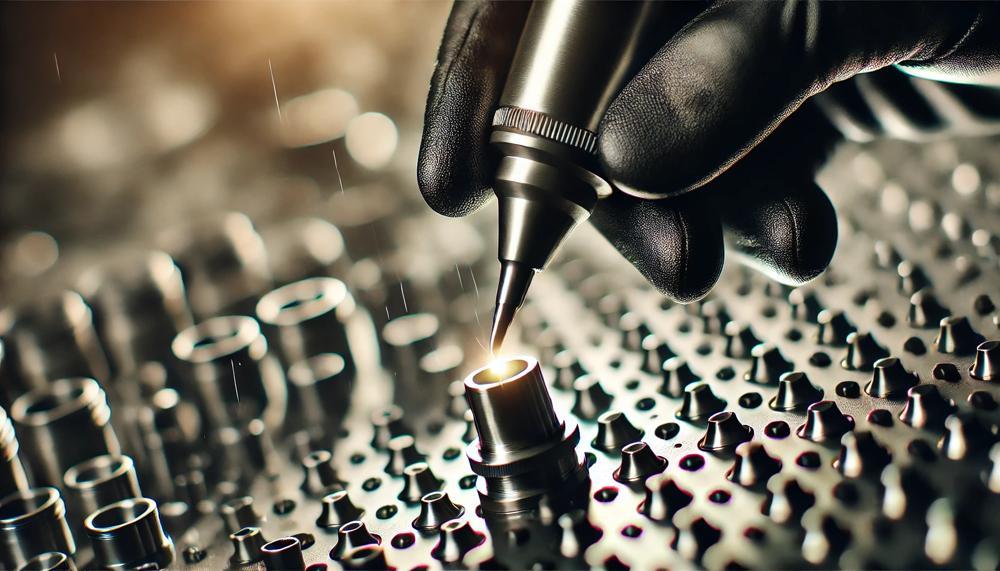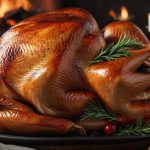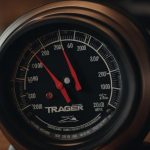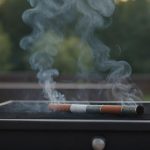Picture this: you’re savoring perfectly charred steaks or tender barbecued chicken straight off the grill. What’s the secret behind achieving such mouthwatering results every time? Enter the humble water pan—a game-changer often overlooked in the realm of grilling.
Why is a water pan essential?
- Temperature Control: Placed strategically above the coals, a water pan acts as a thermal buffer, moderating the grill’s temperature. This ensures your food cooks evenly without the risk of burning or drying out.
- Moisture Retention: The water in the pan creates a humid environment inside the grill, preventing your culinary masterpieces from succumbing to the dreaded dryness that can plague even the most carefully prepared meats.
- Shield Against Flare-Ups: By shielding direct heat from the food, the water pan also mitigates flare-ups caused by dripping grease. This not only enhances safety but also preserves the natural flavors of your ingredients.
Practical Tips for Using a Water Pan:
- Placement: Position the water pan above the heat source but away from direct flames to harness its full benefits.
- Maintenance: Regularly monitor water levels during grilling sessions and replenish with hot water as needed to maintain a stable cooking environment.
- Compatibility: Whether you’re using a charcoal or gas grill, aluminum pans can serve as effective substitutes for dedicated water pans.
In essence, integrating a water pan into your grilling routine is more than just a technique—it’s a gateway to consistently achieving moist, flavorful results that will elevate your culinary prowess. Next time you fire up the grill, consider the impact of this often-underestimated accessory and unlock the secret to grill mastery. Happy grilling.
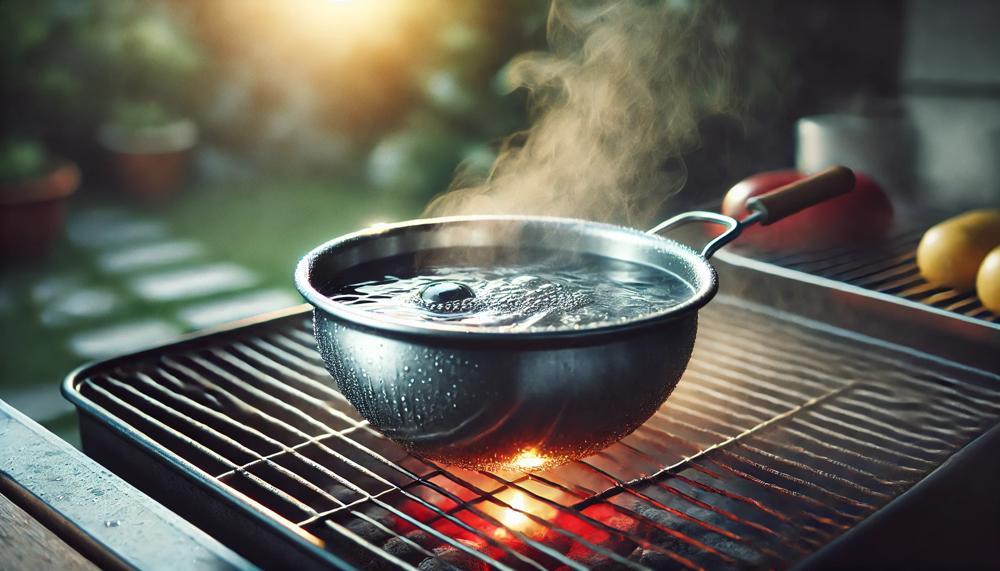
Contents
- 1 Characteristics of Using a Water Pan in a Gas Grill
- 2 What You’ll Learn
- 3 What is a water pan in a gas grill and how does it work?
- 4 Why would I want to use a water pan in my gas grill?
- 5 How do I set up and fill a water pan in my gas grill?
- 6 Can I use anything else besides water in the water pan for added flavor?
- 7 How often should I clean and refill the water pan in my gas grill?
- 8 Conclusion
Characteristics of Using a Water Pan in a Gas Grill
Using a water pan in a gas grill significantly impacts the cooking process and final results. The water pan serves multiple purposes that enhance your grilling experience:
- Moisture Retention: The water pan creates a humid environment inside the grill, which prevents food, especially meats, from drying out during cooking.
- Temperature Regulation: Acting as a heat sink, the water pan helps to regulate the temperature inside the grill. It buffers the heat from direct flames, resulting in more even cooking and reducing the risk of flare-ups.
- Flavor Enhancement: As the water evaporates, it imparts subtle moisture and flavor to the food. This can enhance the taste and juiciness of grilled items.
- Cleaning Ease: The water pan collects drippings and food particles, making cleanup easier and reducing the chances of grease flare-ups.
To use a water pan effectively:
- Fill it with water or another liquid before preheating the grill.
- Monitor the water level during cooking and refill as needed to maintain steam production.
- Regularly clean and refill the water pan to ensure optimal heat distribution and consistent cooking temperatures.
In summary, using a water pan in a gas grill not only helps in maintaining moisture and temperature control but also contributes to a cleaner and more flavorful grilling process.
What You’ll Learn
| Key Takeaway | Insight | Details |
| Moisture Regulation | The water pan helps keep food moist. | The evaporation of water creates steam, which adds moisture to the cooking environment. |
| Temperature Control | It aids in stabilizing grill temperatures. | Acts as a heat sink, distributing heat evenly and preventing sudden temperature fluctuations. |
| Preventing Flare-Ups | Reduces the risk of flare-ups. | Acts as a barrier between dripping fats and flames, ensuring safer grilling. |
| Enhanced Flavor | Improves the taste of grilled food. | The steam from the water pan imparts a subtle yet distinct flavor to the food. |
| Versatility | Allows for different cooking methods. | Enables smoking or slow roasting through indirect heat techniques. |
| Maintenance and Cleanup | Simplifies post-grilling cleanup. | Catches drippings and grease, making grill cleaning easier. |
What is a water pan in a gas grill and how does it work?
A water pan in a gas grill is a shallow tray typically filled with water or other liquids positioned beneath the grill’s cooking grates. Its primary function is to enhance the grilling process by adding moisture and regulating temperature.
| Function | Description | Importance |
| Moisture Enhancement | Creates steam when heated, keeping food moist during cooking. | Prevents drying out of food, especially lean meats. |
| Temperature Regulation | Acts as a heat sink, distributing heat evenly and reducing flare-ups. | Ensures consistent cooking temperatures. |
| Flavor Infusion | Allows for adding herbs, spices, or other aromatics to the water, enhancing food taste. | Enhances the overall flavor profile of grilled dishes. |
| Cooking Versatility | Facilitates indirect cooking methods for delicate foods. | Enables a variety of grilling techniques. |
| Cleanup Simplification | Collects drippings, making grill cleanup easier. | Helps maintain grill cleanliness. |
Using a water pan involves filling it before heating the grill, monitoring water levels during cooking, and following the grill manufacturer’s instructions.
Why would I want to use a water pan in my gas grill?
Using a water pan in your gas grill is akin to enlisting a skilled assistant in your barbecue endeavors. It serves multiple functions that elevate your grilling game, ensuring your meats remain succulent, your temperatures steady, and your flavors enhanced. Here’s how it helps:
- Temperature Control: The water in the pan moderates the grill’s internal temperature, absorbing excess heat to prevent overheating and releasing heat slowly if temperatures drop, ensuring a more consistent cooking environment.
- Moisture Retention: As the water heats, it evaporates, increasing the humidity inside the grill. This steamy environment helps in keeping the meat moist throughout the cooking process, which is especially beneficial for long-duration smoking sessions.
- Flavor Enhancement: The moist environment not only benefits texture but also enhances the smoke flavor that adheres to the meat, giving you that irresistible smoky barbecue taste.
- Protection from Flare-Ups: Strategically placed between the heat source and the meat, the water pan also acts as a barrier, shielding the food from direct flames and heat, which helps in preventing burns and drying out of the meat.
How do I set up and fill a water pan in my gas grill?
Setting up and filling a water pan in your gas grill is straightforward but essential for achieving succulent grilled dishes. Here’s a step-by-step guide to ensure your grilling is both smooth and successful:
- Select the Right Pan: Choose a water pan that’s large enough to fit your grill but shallow enough to sit beneath the cooking grates. Metal pans are preferred due to their durability and heat conductivity.
- Positioning the Pan: Place the pan on the grill grates, ensuring it’s situated away from direct heat sources. This placement allows the pan to catch drippings from the food above and add moisture without the water boiling away too quickly.
- Fill the Pan: Pour hot water into the pan before you start grilling. Filling it with hot water helps maintain the grill’s temperature. Ensure the water level is just below the rim to allow space for expansion and avoid spillage.
- Monitoring and Refilling: During grilling, keep an eye on the water level. Refill the pan as necessary to prevent it from drying out, which could lead to uneven cooking and a lack of moisture.
- Maintenance: After each grilling session, allow the pan to cool before emptying it. Clean the pan every 2-3 months or as needed. Scrub it with warm soapy water, rinse, and air-dry to prevent rust and ensure longevity.
Can I use anything else besides water in the water pan for added flavor?
Yes, you can use other liquids besides water in the water pan of your grill, although the effect on the flavor of your food might be subtler than you expect. Hot water remains the top choice for maintaining ideal cooking temperatures and moisture, but alternatives like wine, beer, and juices can introduce a mild, aromatic quality to the smoke that surrounds your food, enhancing the grilling atmosphere more than the food itself.
While exploring these options, it’s crucial to remember that the primary function of the water pan is to stabilize temperature and add humidity inside the grill. Substituting water with other liquids should be done with this purpose in mind.
Below is a table that outlines some popular alternatives and their effects:
| Liquid | Description | Effect on Food |
| Wine (Red/White) | Can add a subtle fragrance depending on the type used. | Enhances the ambiance with a delicate aroma, minimal direct flavoring to food. |
| Beer | A light beer or ales can impart a very mild taste. | Mostly affects the aroma during cooking; direct taste changes are minor. |
| Fruit Juices (Apple, Citrus, etc.) | Sweet, tangy profiles depending on the juice. | Introduces a slight sweetness or tanginess to the smoke, affecting food aroma. |
| Herbs and Spices | Herbs like rosemary, thyme; spices like cinnamon sticks can be added to the water. | Creates fragrant smoke, subtly impacting the flavor notes of grilled items. |
For a more pronounced effect, consider placing these flavor enhancers directly on the coals or incorporated into a smoking pouch.
This direct application can more effectively infuse the food with the desired flavors, turning a simple grill session into a fragrant feast.
How often should I clean and refill the water pan in my gas grill?
To ensure your gas grill performs optimally, it’s advisable to clean and refill the water pan frequently. Clean the water pan every time you use the grill if you cook often or prepare greasy foods. For less frequent use, a thorough cleaning every two to three months is sufficient.
Always refill the water pan with fresh water before each grilling session to maintain a moist environment that prevents drippings from burning and enhances food flavour.
Cleaning Steps:
- Turn off the gas supply to ensure safety.
- Remove the water pan carefully to avoid spillage.
- Scrub the pan using warm soapy water to remove grease and food residue.
- Rinse thoroughly and air dry the pan before placing it back in the grill.
Refilling Tips:
- Refill with clean water each time you grill.
- Keep the water level consistent during cooking, topping it up as necessary to avoid drying out, which could lead to burnt flavours.
Why Regular Maintenance is Key:
Regular cleaning and refilling help in preventing flavour cross-contamination and ensure that the humidity levels within the grill are optimal for cooking, keeping your meats tender and juicy.
This routine also extends the lifespan of your grill components by preventing rust and damage from accumulated grease.
Practical Guide for Water Pan Maintenance:
| Frequency | Activity | Reason |
| Each use | Refill with fresh water | Maintains moisture for cooking and prevents drippings from burning |
| Each use (if frequent/grilling greasy foods) | Clean after cooking | Prevents build-up of grease and residue |
| Every 2-3 months | Thorough cleaning | Ideal for less frequent use; prevents long-term wear and tear |
Conclusion
In conclusion, incorporating a water pan into your grilling setup can profoundly enhance your culinary outcomes.
This often-overlooked accessory plays a pivotal role in maintaining optimal cooking conditions by regulating temperature, preserving moisture, and shielding food from flare-ups. By strategically placing a water pan above the heat source, grillers can ensure even cooking without the risk of burning or drying out.
The humid environment created by the water pan not only prevents meats from succumbing to dryness but also infuses them with subtle flavors, elevating the taste profile of your grilled dishes. Furthermore, the practical benefits extend to easier cleanup as the water pan collects drippings and reduces grease flare-ups.
So, next time you fire up the grill, consider the transformative impact of this simple yet indispensable tool and savor the juicier, more flavorful results it helps achieve.

